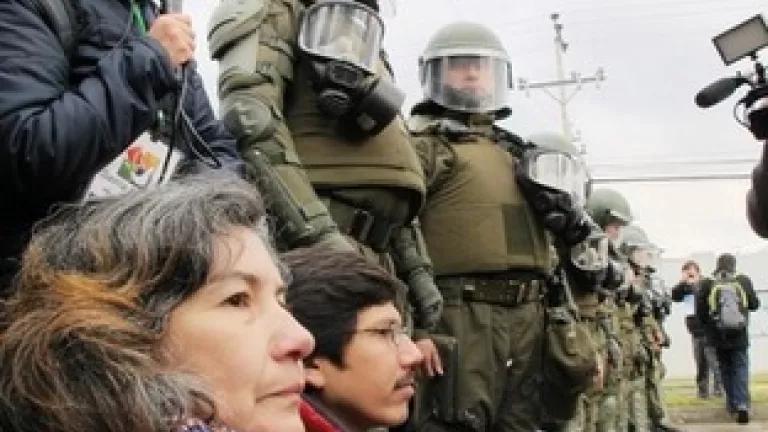Approval of another large dam in Patagonia -called Río Cuervo- highlights Chile's priority to ramp up energy generation, even at the potential expense of human safety

The regional environmental authorities in Chile’s Patagonian region of Aysén unanimously approved a large hydroelectric project today, called Río Cuervo (named for the river it will dam). The approval came amid public protest and despite widespread knowledge of the woeful state of the project’s environmental impact assessment and warnings from scientists and engineers that this is an inherently bad project. This approval demonstrates, without question, that the government values large industrial interests far above the well-being and the wishes of its citizens.
Sound familiar?
It was almost a year ago to the day that these very same authorities approved the environmental impact assessment for the massive five-dam hydroelectric scheme called HidroAysén. With an installed capacity of 2,750 megawatts and requiring a new 1,200 mile-long transmission line, HidroAysén’s sheer size has drawn national and international attention and controversy for years. Its approval sparked the largest public demonstrations (here’s a video I took of the protests) that Chile had seen at that time since the military dictatorship (this was before the student protests last year). Since then, legal challenges against HidroAysén have gone all the way to the Supreme Court. The court ruled 3-2 to uphold the project’s approval, but there are still many ways to stop HidroAysén – including addressing the transmission line’s environmental review process, which should start at the end of the year.
As HidroAysén’s legal challenges proceeded over the past year, they seem to have over-shadowed the ongoing evaluation of the Río Cuervo dam. But Río Cuervo is no less important to fight – and even poses a more direct threat to the local communities than HidroAysén.
Residents -and police- lined up outside the Aysen regional authority's office to await the decision. Photo courtesy of Peter Hartmann, CODEFF Aisen.
Here are a few basics about Río Cuervo:
- The owner of the project is Energía Austral, the Chilean subsidiary of the Swiss mining company Xstrata Copper. In April, Xstrata sold 51 percent of its stake in Energía Austral to the Australian energy company Origin Energy, Ltd., and still maintains the other 40 percent.
- Río Cuervo would have an installed capacity of 640 MW. But the company intends to build two other dams –Condor and Blanco (again, named for the rivers they would dam) – making the combined installed capacity of the three dams just over 1,000 MW.
- The Río Cuervo is further north and west in Patagonia than the Baker and Pascua Rivers (where HidroAysén is planning its dams), close to the town of Puerto Aysén. Here’s a good map of the Río Cuervo project, the proposed dams and its proximity to Puerto Aysén.
- The approval process took more than two years, during which time the project’s environmental impact assessment was repeatedly cited for lacking important information.
So what’s so bad about the Río Cuervo dam?
The main issue is serious, glaring and undeniable: the dam would be located on top of the Liquiñe-Ofqui fault system. In other words, it would be in the middle of an active earthquake zone, which caused a 6.2 earthquake in Aysén in 2007 and an ensuing tsunami, leading to the deaths of ten people. The area also contains the active Caulle Volcano Chain, where the Hudson Volcano erupted in October 2011. Well-known Chilean geophysicist Luis Donoso called Río Cuervo’s approval an “aberration and an absolute blunder.”
The poor siting of the project has led many to compare it to the Vajont Dam in Italy, which caused a tragic disaster that killed around 1000 people in 1963. There, dam proponents ignored warnings about the geological instability of the nearby mountains, and a landslide fell in the dam’s reservoir, sending an enormous wave of water downstream that wiped out villages. The people of Puerto Aysén fear that, if the geological instability of the area causes a problem with the Río Cuervo dam, they will be the ones to pay for it – potentially with their lives. Here is a computer visualization from the Universidad Tecnológica Metropolitana of what would happen if the Río Cuervo dam ruptured – notice the time in seconds at the top left corner, indicating how quickly the area would be flooded.
Another key argument against the Río Cuervo dam’s approval is the fact that only the one dam was evaluated, even though it is part of a three-dam hydroelectric plant. Fracturing the project for environmental evaluation this way, submitting each dam separately, makes it easier for the company to get approval. But it also prevents the evaluators and the public from seeing the all of the cumulative impacts and risks of the project as a whole. Also, and again similar to HidroAysén, the evaluation did not include the needed transmission line. Fracturing projects this way, by the way, is illegal according to Chile’s new environmental impact review legislation (passed in 2010, after Río Cuervo was already in process).
There are further major problems with the Río Cuervo dam and its environmental impact assessment, as well as more similarities to HidroAysén, which I will address in another blog tomorrow.
What is clear today is that, again, Chile’s government has given overt priority to foreign industrial interests and energy development –development that is over 1,000 miles away from Chile’s growing energy demand– over everything else, including the safety of its citizens in Puerto Aysén.
